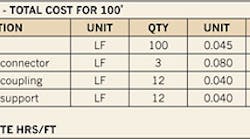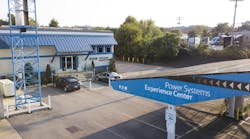The process of tracking production is arguably the most important skill a project leader can master. Whether you're a crew leader, foreman, superintendent, or project manager, learning the skills necessary for effective production tracking will help your career immensely. The challenge is production tracking is not a simple black and white process. It's a thought process that encompasses many factors — where you're at, how fast you're going, and where you'll be daily (or even hourly). By building this thought process into all project leaders in your company, you will create a culture of productivity and build a common language that everyone from the apprentice to the estimator to the controller can share.
Production tracking strategies
To create such a culture, there are two key strategies, both of which have their time and place. For maximum productivity, it's critical to understand and use both.
Daily minimum production — This method works best when the production task duration is long and the crew size is relatively fixed. In this method, you set a fixed crew size and a daily minimum production level. In this case, it would be a backhoe crew, and the daily minimum production would be 100 feet completed per day. The same could hold true for branch conduit, feeders, wire, light fixtures, or other tasks.
Dynamic production tracking — This method requires heavier math skills, more training, and a lot more planning. However, it works in all situations and helps to build a “production mind-set” into the project and organization. Dynamic production tracking requires breaking every project down into specific production tasks, establishing production units, setting production targets, and then putting a system in place to track both quantity and costs in order to arrive at a daily production number.
Figure 1 (click here to see Fig. 1)shows an example of dynamic production tracking for the underground task of (2) X 6-inch duct bank. This summarizes the activity each day, including costs and quantity installed. The rates are conservative (increased slightly from estimate) to account for miscellaneous items that may not have been accounted for, such as fuel, maintenance, deliveries, punch list time, etc.
From the looks of it, the crew just walked into Day 1 with little planning, worked a normal day, and made target production. There was a push made to increase that production and finish in four days — beating the target production rate by $0.40 per foot and saving a few hundred dollars.
Although this may seem like a small savings, repeating this process every day throughout the project could add up to tens or even hundreds of thousands of dollars, depending on the size and complexity of the project.
When you learn the basics of production, you will start to pencil out various “what-if” scenarios to see what effect different crew configurations and targets have on the bottom line.
Figure 2 (click here to see Fig. 2) shows what would have happened if the production had remained the same as the first day. First of all, it would have taken a full week to complete the task. More than likely, even though only 60 feet of production was required on the last day, the rest of the time would have been spent on cleanup and other non-productive activities in preparation for the weekend. Notice that this comes out to an average cost of $20.05 per foot, or $1.39 per foot more than planned. This would begin the job over budget by $640 — not the best way to start a project.
The example we just went through was fairly straightforward. What about something more difficult, such as branch conduit, which is estimated using a unit-based method and made up of a combination of different units, including conduit and boxes of various sizes?
Tracking unit estimated work (branch conduit example)
The composite take-off units will be the major items from the estimate. Each of these is actually an assembly made up of many detailed units, including supports, couplings, connectors, box covers, etc. These are all part of the estimating database. To track production for these types of items, start with the assembly details, summarizing them into the take-off units, and finally consolidating those down to a common production tracking unit.
An example of an assembly is shown in Table 1 for ½-inch EMT, and includes the couplings, connectors, and supports, with averages for placement. The rates were taken from the NECA manual of labor units. This assembly arrives at a composite rate for ½-inch EMT of 0.057 hours per foot. The next step is to summarize the individual assemblies into composite units. Table 2 shows a typical example of how these would look. Each company will have their individual assemblies and rates used for estimating, which determines where their production targets need to be.
Creating common units and multipliers
While working on the underground duct bank, the whole crew was working on a single task for the entire day, and it was easy to measure production — footage of trench that was backfilled and finished each day. When crews are working on something inside the building, such as branch conduit, they are working on everything including all sizes of conduit as well as junction boxes.
There are two ways to handle this. The first is impractical and involves tracking how much time is spent on each of these different items by person and then checking the production for each item. The second is to create a common unit and have multipliers for all other units to convert them (Table 3). This is no different than converting cubic feet to cubic yards by dividing the cubic feet by 27. In this case, we will choose 1 foot of ½-inch EMT as our common unit, and call it a “branch foot.” To convert other units into a branch foot, we assign a multiplier, which is determined by dividing the labor unit by the ½-inch EMT labor unit.
For example, to create the multiplier for ¾-inch EMT, we would take the ¾-inch EMT unit of 0.064 and divide it by the common unit (½-inch EMT) of 0.057. Rounding to the nearest single decimal is recommended for ease of use in the field. This multiplier comes out to 1.1, which means that running 10 feet of ¾-inch EMT is about the same as running 11 feet of ½-inch EMT.
Remember, there are only about five big production items on a project that should be tracked, which will be similar from project to project. If you put in the work up-front, you can set up production tracking systems and daily minimums for the entire company in just a few days.
Determining target production figure is pretty simple. Let's use ½-inch EMT as an example.
-
Common unit = ½-inch EMT/foot (branch foot)
-
Hours per common unit = 0.057
-
Average labor rate = $37.50/hr (from est.)
-
Minimum production = $2.13/ft (0.057 × $37.50)
Therefore, your target production is $2.13 per branch foot.
A variety of other things can be tracked on the project using similar methodologies, including the following:
-
Add MC cable to branch conduit using multipliers.
-
Branch wire/cable — break everything down to 12 AWG equivalent, including makeup.
-
Light fixtures — break everything down to 2×4 lay-in fixture equivalent, including earth quaking and whips.
-
Feeder conduit and wire — model the same as branch.
-
Devices and trim — break everything down to duplex outlet level.
-
Equipment rooms — track production as single unit setting cost and time goals.
Menu-style production tracking
An alternative to the common unit method would be to use something called menu-style production tracking. This method lends itself to a combination of task- and production-driven work items and also a varying crew mix. Common areas where this method makes sense include utility contractors who are doing some production work such as trenching, but who are also assembling and setting valves, preparing junction structures, etc. This method also works well for equipment rooms with a variety of equipment, panels, conduit, etc.
The basis of the method is that during the pre-planning you break the work down into the various tasks, not necessarily based on the estimate but rather on how the work will actually be installed. Based on the estimate, each of these tasks has a quantity and labor/equipment number assigned to it. This is the “menu” of production items that the crew chooses as complete each day, either for tracking or planning purposes.
A quick extension of the quantities completed for the day multiplied by the labor/equipment budget will show how much budget has been “earned” for the day. The second part is to do a calculation of the cost for the day using labor/equipment costs from the estimate. It's important to use costs from the estimate (rather than actual), because you're tracking production at this point — not costs. If you end up having to pay more or less money for the same manpower or equipment, then that is a procurement issue, which should be treated separately from a production issue.
By subtracting the crew cost for the day from the earned budget, you will get a daily profit (loss) for the crew. An example for an electrical power room is shown in Table 4. The power room was broken down into specific tasks with quantities and budgets assigned.
Factoring in “non-production” time
This is a key “gotcha” area that can come back and bite you if you don't plan for it. Say you're going along and meeting the production goals for branch installation, and everyone is celebrating throughout the week. Then it is time for inspection, so you send a couple of people around for the day to “clean up” the area, strapping fire caulking, labeling conduits, etc. What do you do with this time? It is a pretty big cost (two people for a day), but there was no real production associated with it. What if there was a day up-front where a couple of people did some pre-fabrication and layout work? There are two primary methods of dealing with these additional costs:
Add-in: When summarizing production, you factor in “zero” production days for pre-fabrication, planning, cleanup, and punch list as a cost only — no production.
Subtract from (recommended): Conservatively estimate the non-productive activities and back out the cost per unit from the production goal.
Using this method, you simply calculate the cost for the non-production activities and use those costs in calculating the overall production rate. The danger is that this approach does not set a production target for the crews as they are installing on a daily basis. Therefore, it's easy to have a production overrun.
The recommended method is to use the production tracking sheets to conservatively estimate the costs of these non-production activities. You can then estimate the total quantity to be installed. Keep in mind you'll want to estimate conservatively low in this case, so that you don't create too low of a deduction. Finally, you will arrive at a deductive amount that you can back out of your originally calculated production target, which will give you a revised target for the crews to focus on.
Some areas in which you may put this method to good use would be revising the production calculation, if you have a large project and there is both a non-working foreman and material handler, along with several crews installing branch conduit. To revise that production target, you would:
-
Take the cost of the material handler and foreman for the week.
-
Estimate how many branch feet you should be installing with the crews you have.
-
Divide the total cost of the foreman and material handler by the estimated number of branch feet to achieve your deductive cost/unit.
Brown is the founder/president of D. Brown Management, a consulting firm located in Lodi, Calif. He can be reached at [email protected].



